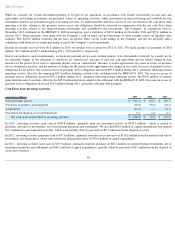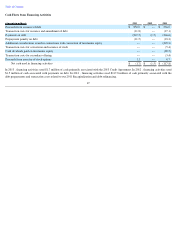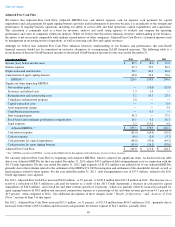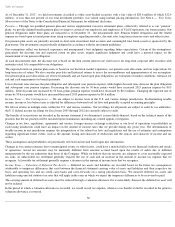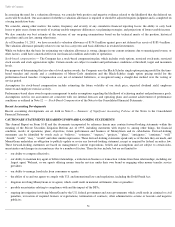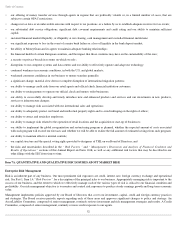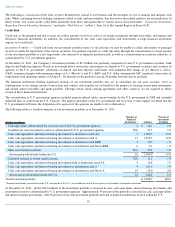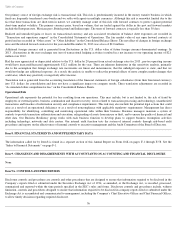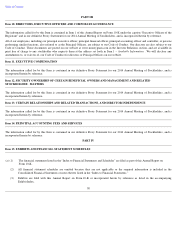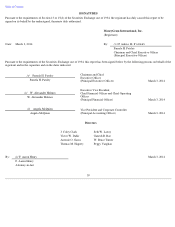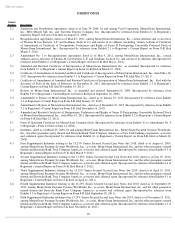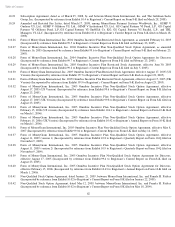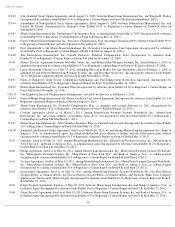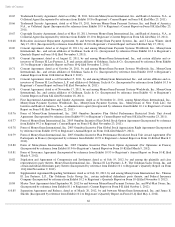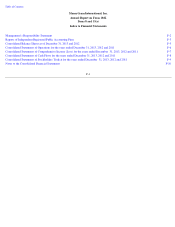MoneyGram 2013 Annual Report Download - page 58
Download and view the complete annual report
Please find page 58 of the 2013 MoneyGram annual report below. You can navigate through the pages in the report by either clicking on the pages listed below, or by using the keyword search tool below to find specific information within the annual report.
Table of Contents
Our primary source of foreign exchange risk is transactional risk. This risk is predominantly incurred in the money transfer business in which
funds are frequently transferred cross-
border and we settle with agents in multiple currencies. Although this risk is somewhat limited due to the
fact that these transactions are short-
term in nature, we currently manage some of this risk with forward contracts to protect against potential
short-
term market volatility. The primary currency pairs, based on volume, that are traded against the dollar in the spot and forward markets
include the European euro, Mexican peso, British pound and Indian rupee. The tenor of forward contracts is typically less than 30 days.
Realized and unrealized gains or losses on transactional currency and any associated revaluation of balance sheet exposures are recorded in
“Transaction and operations support”
in the Consolidated Statements of Operations. The fair market value of any open forward contracts at
period end are recorded in “Other assets”
or "Other liabilities" in the Consolidated Balance Sheets. The net effect of changes in foreign exchange
rates and the related forward contracts for the year ended December 31, 2013 was a loss of $2.0 million .
Additional foreign currency risk is generated from fluctuations in the U.S. dollar value of future foreign currency-
denominated earnings. In
2013 , fluctuations in the euro exchange rate (net of transactional hedging activities) resulted in a net increase to our operating income of
$2.1
million over 2012 .
Had the euro appreciated or depreciated relative to the U.S. dollar by 20 percent from actual exchange rates for 2013 , pre-
tax operating income
would have increased/decreased approximately $12.1 million
for the year. There are inherent limitations in this sensitivity analysis, primarily
due to the assumption that foreign exchange rate movements are linear and instantaneous, that the unhedged exposure is static, and that we
would not hedge any additional exposure. As a result, the analysis is unable to reflect the potential effects of more complex market changes that
could arise, which may positively or negatively affect income.
Translation risk is generated from the accounting translation of the financial statements of foreign subsidiaries (from their functional currency)
into U.S. dollars for consolidation and does not have a significant impact on company results. These translation adjustments are recorded in
"Accumulated other comprehensive loss" on the Consolidated Balance Sheets.
Operational Risk
Operational risk represents the potential for loss resulting from our operations. This may include, but is not limited to, the risk of fraud by
employees or external parties, business continuation and disaster recovery, errors related to transaction processing and technology, unauthorized
transactions and breaches of information security and compliance requirements. This risk may also include the potential legal actions that could
arise as a result of an operational deficiency or as a result of noncompliance with applicable regulatory requirements. Management has direct
responsibility for identifying, controlling and monitoring operational risks within their business. Business managers maintain a system of
controls to provide transaction authorization and execution, safeguarding of assets from misuse or theft, and to ensure the quality of financial and
other data. Our Business Resiliency group works with each business function to develop plans to support business resumption activities
including technology, networks and data centers. Our internal audit function tests the system of internal controls through risk-
based audit
procedures and reports on the effectiveness of internal controls to executive management and the Audit Committee of the Board of Directors.
Item 8. FINANCIAL STATEMENTS AND SUPPLEMENTARY DATA
The information called for by Item 8 is found in a separate section of this Annual Report on Form 10-K on pages F-1 through F-
58. See the
“Index to Financial Statements” on page F-1.
Item 9. CHANGES IN AND DISAGREEMENTS WITH ACCOUNTANTS ON ACCOUNTING AND FINANCIAL DISCLOSURE
None.
Item 9A. CONTROLS AND PROCEDURES
Disclosure controls and procedures are controls and other procedures that are designed to ensure that information required to be disclosed in the
Company’
s reports filed or submitted under the Securities Exchange Act of 1934, as amended, or the Exchange Act, is recorded, processed,
summarized and reported within the time periods specified in the SEC’
s rules and forms. Disclosure controls and procedures include, without
limitation, controls and procedures designed to ensure that information required to be disclosed in company reports filed or submitted under the
Exchange Act is accumulated and communicated to management, including the Company’
s Chief Executive Officer and Chief Financial Officer,
to allow timely decisions regarding required disclosure.
56


